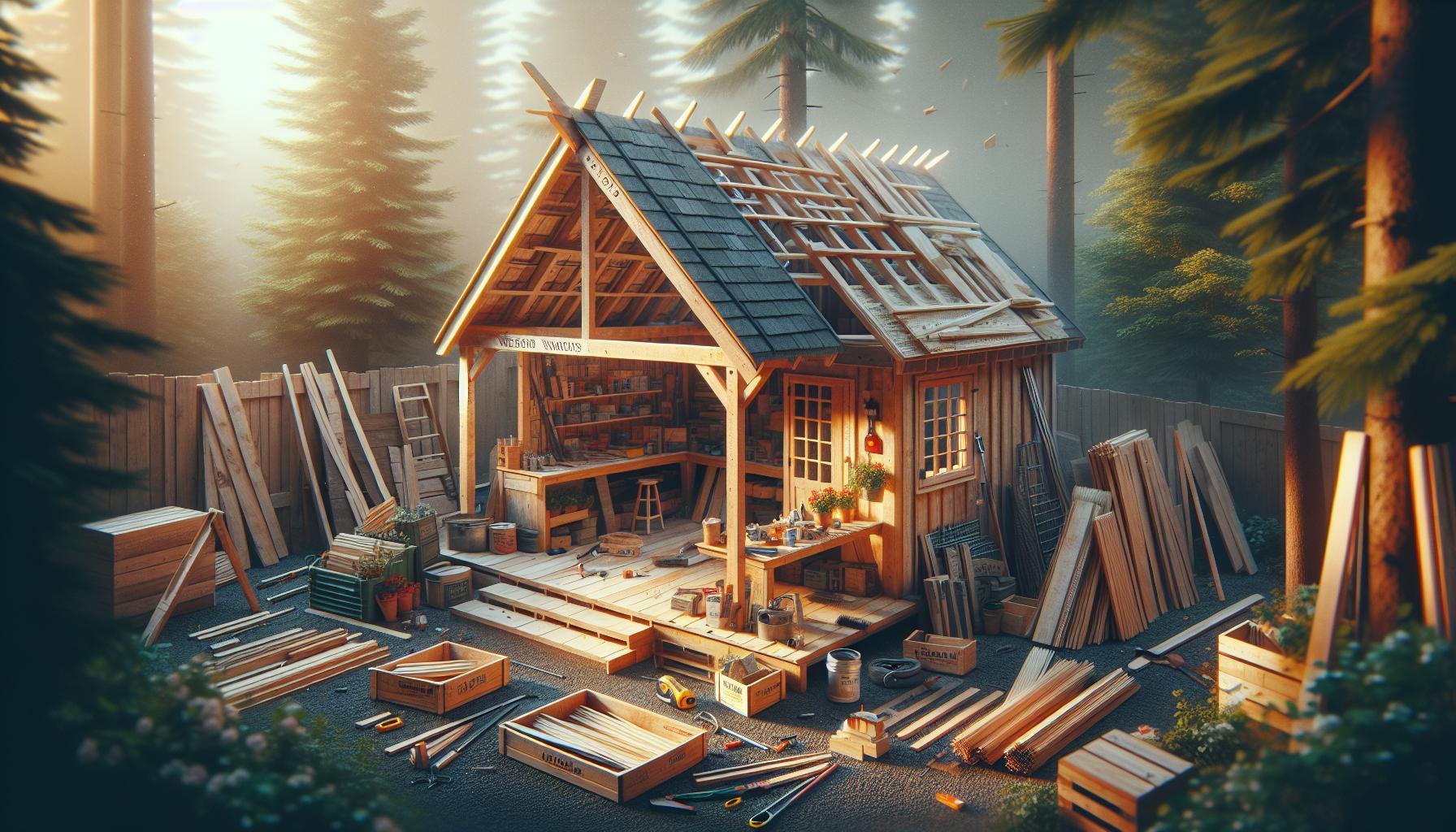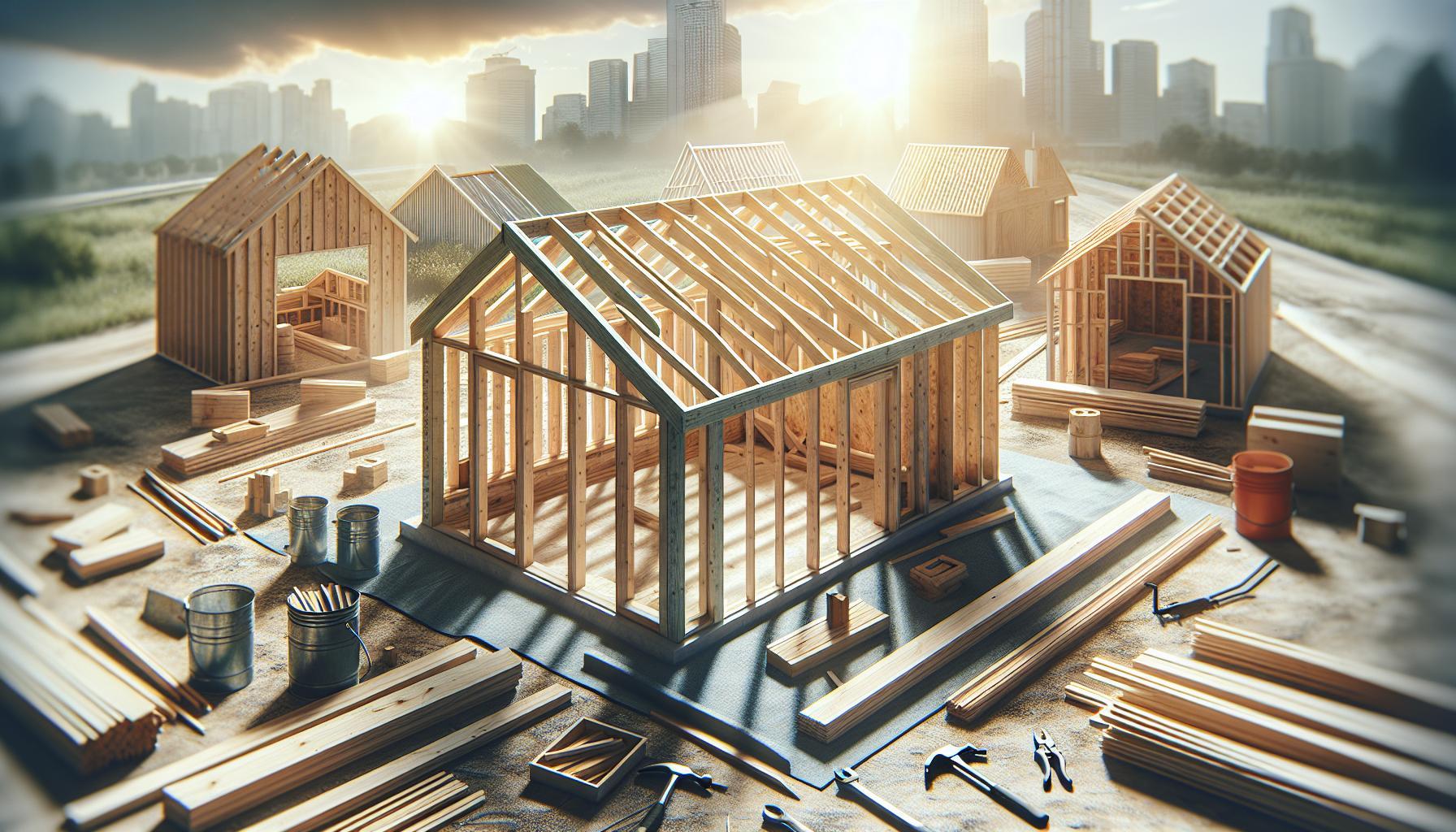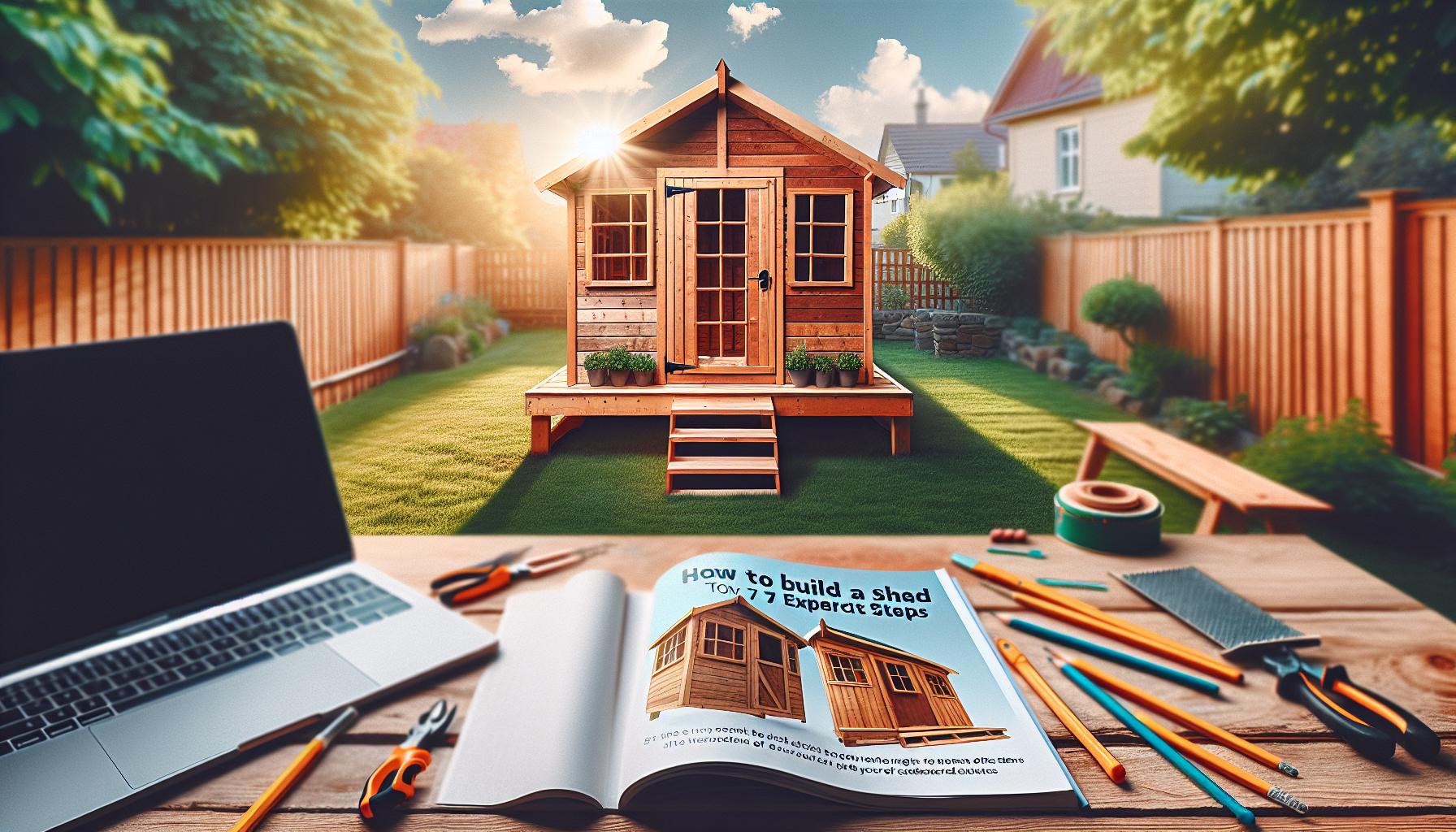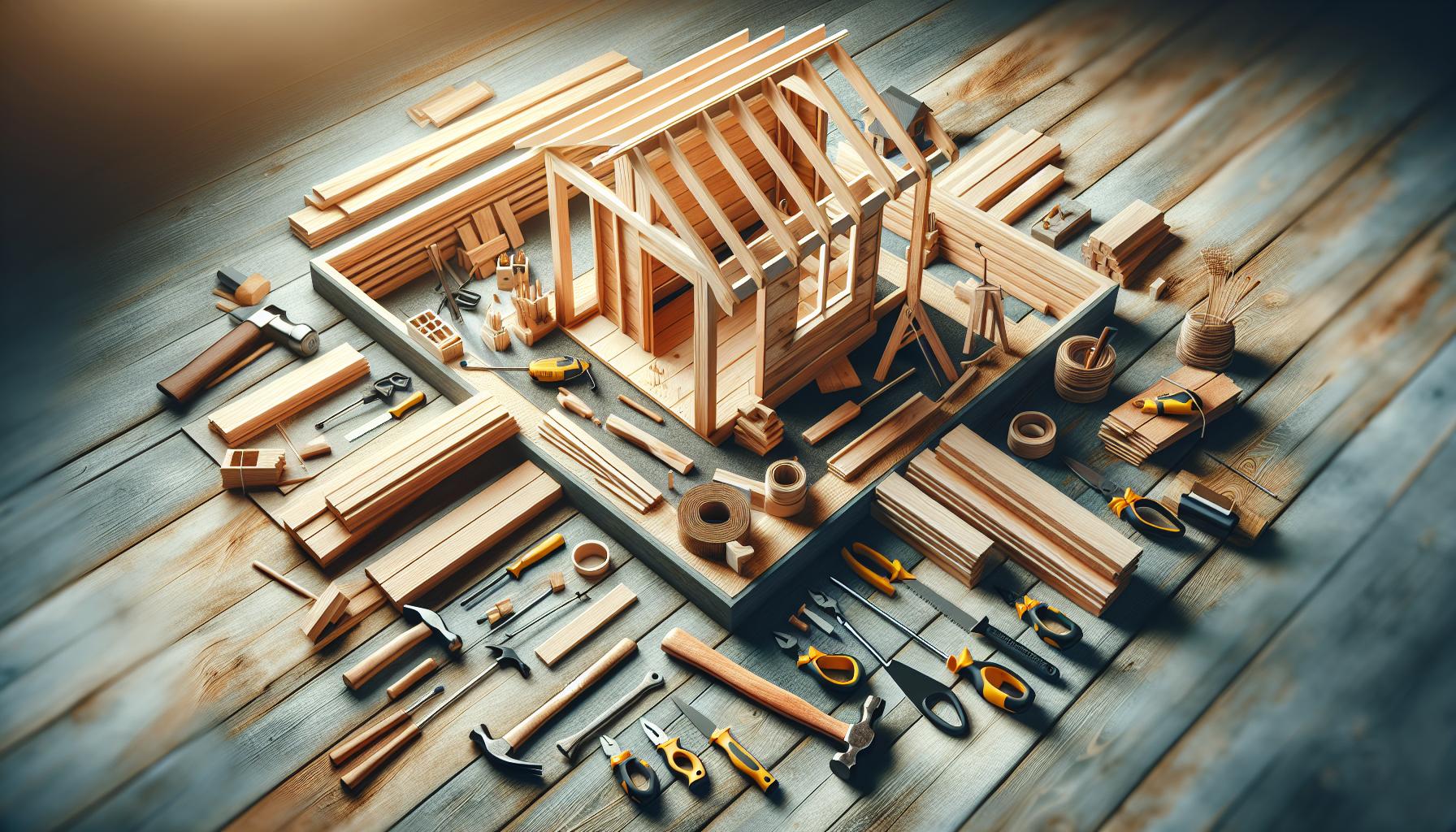Are you tired of not having enough storage space or a dedicated area for your hobbies? Building a shed can be a game-changer, offering an efficient solution that enhances your outdoor space. This guide simplifies the process, providing you with step-by-step instructions to create a durable and functional shed over the weekend. Say goodbye to clutter and hello to your new sanctuary!
Choosing the Right Shed Design: Finding Your Perfect Fit
When embarking on your shed-building journey,the design you choose can significantly influence not onyl the aesthetics but also the functionality of your garden space. With countless styles and configurations available, it’s essential to select a shed that aligns with your specific needs, whether it’s for gardening supplies, tools, or a quiet retreat. A well-planned shed can enhance your backyard, integrating seamlessly with your home and landscape.
### Evaluate Your Needs
Before diving into design specifics, take a moment to assess what you will be using the shed for. Consider the following factors:
- Storage Requirements: How much space do you need for your tools and materials? Will you need shelves, hooks, or floor space for larger items?
- Functionality: Is this shed merely a storage unit, or do you plan to use it as a workshop or hobby space? A workstation might require additional electrical wiring and ventilation.
- Aesthetic Preferences: Think about how the shed will fit within your existing landscape. Do you prefer a rustic look, a modern design, or perhaps a quaint garden shed style?
### Choosing Shed Materials
The material you choose for your shed affects both its longevity and maintenance needs. Here’s a fast comparison of common shed materials:
| Material | Durability | Maintenance | Cost |
|---|---|---|---|
| Wood | High | Regular painting/sealing required | moderate to High |
| Metal | Very High | Low maintenance, rust prevention needed | Moderate |
| Vinyl | High | Minimal, occasional washing | Moderate |
### Customization and Design Features
Once you have a solid understanding of your needs and materials, it’s time to explore design specifics. Customization can play a vital role in making your shed truly yours. This includes choosing:
- Roof style: Consider the local climate. A sloped roof may be beneficial in snowy regions, while a flat roof might suit warmer areas.
- Windows and Doors: Adding windows not only enhances ventilation but also allows natural light to flow in, making the shed more inviting.
- color Schemes: Select a color that complements your home and garden; this adds visual appeal and harmony to your outdoor space.
Engaging in a thoughtful planning process will ensure that your shed is not just another structure but a functional and gorgeous addition to your home. Whether you’re following guides on how to build a shed efficiently or seeking inspiration from innovative designs, aligning your shed with both your practical needs and aesthetic desires is key to truly finding your perfect fit.
Tools and materials You’ll Need: A Comprehensive Checklist
Building a shed can be an exciting and rewarding project, but having the right tools and materials is crucial to ensure efficiency and success. Being prepared will not only save you time and frustration but also help you create a sturdy and functional space that meets your needs. A well-organized checklist can serve as your roadmap during the construction process, ensuring nothing is overlooked.To get started, here’s a comprehensive list of essential tools and materials you’ll need for your shed construction:
Essential Tools
- Measuring Tape: Accurate measurements are key to a triumphant build.
- Level: ensure that your base and framing are perfectly horizontal.
- Square: Use this to create perfect right angles in your framework.
- Drill/Driver: A power drill is essential for creating holes and driving screws.
- Saw: Depending on the materials, a circular saw or miter saw will be necessary.
- Hammer: A reliable tool for driving nails into lumber.
- Safety Gear: Don’t forget gloves, goggles, and ear protection.
building Materials
- Wood: Select quality lumber for framing, plywood for the walls, and treated wood for the floor.
- Roofing Material: Choose between shingles, metal, or another suitable roofing solution.
- fasteners: Gather a selection of nails, screws, and brackets specific to the wood type.
- Paint or Stain: Finishing products to protect the wood and enhance aesthetics.
- Concrete Mix: For a solid foundation, especially for larger or more permanent sheds.
Incorporating these tools and materials into your planning phase will streamline the process outlined in “How Build a Shed: Weekend WarriorS Guide to Fast Construction.” Remember, preparation is not just a step; it’s a vital part of the journey that can significantly impact the quality of your final product. Assemble your checklist, gather your supplies, and you’ll be ready to take on the construction with confidence.
Step-by-Step Preparation: Laying the Groundwork for Success
When embarking on your project to construct a shed, diligent preparation is essential. It can spell the difference between a hacking it together haphazardly and building a structure that stands the test of time. Taking the time to lay down the groundwork effectively involves more than just the physical site—it’s about planning the entire process and ensuring everything is in place for a streamlined experience. By focusing on these preparatory steps, you set yourself up for a successful build that aligns with your vision and goals.
Assessing the Site
Before you even think about materials and tools, take a moment to evaluate the area where your shed will take root.Look for a location that is relatively flat and well-drained. Avoid spots that collect water, as moisture can lead to premature rot and structural issues. If necessary, consider leveling the ground or building a platform to raise your shed above possible flooding or water runoff. Here are some considerations for choosing the perfect spot:
- Avoid low-lying areas where water collects.
- Ensure the area is accessible for delivery of materials and easy for you to work.
- Keep in mind local zoning laws and your property’s boundaries to avoid future conflicts.
Obtaining Necessary Permits
Before starting construction, it’s imperative to check local regulations regarding building permits. While many backyard structures, such as sheds, may not require extensive permits, skipping this step could lead to unexpected roadblocks later on. Securing the necessary permits not only ensures compliance but can also save you from having to dismantle your project down the road. Always confirm specific requirements with your local building department.
Planning and Designing Your Shed
With the site set and permits lined up,detailed planning comes next. This is where the blueprint of your vision takes shape. Decide on the size, style, and functionality of your shed. Will it be a simple storage unit, or will you include features like shelving, windows, or electrical wiring? Drawing up a detailed plan or blueprint not only helps visualize the project but serves as a valuable reference throughout the construction process.
| Dimension | Approximate Cost |
|---|---|
| 10′ x 10′ | $2,200 |
| 10′ x 12′ | $2,700 |
| 12′ x 12′ | $3,200 |
| 12′ x 20′ | $5,200 |
Choosing the right materials also plays a crucial role. Referencing resources like cost comparisons can definitely help you budget effectively as you gather supplies. Remember, investing in quality materials now can save time and money on repairs down the line.
By prioritizing these preparatory steps, builders enter the construction phase equipped with a clear pathway to follow, all but ensuring their shed becomes the weekend warrior’s success story envisioned in guides like “How to Build a Shed: Weekend Warrior’s Guide to Fast Construction.” Set a solid foundation today for a stress-free build tomorrow.
Constructing the Foundation: Strong Support for Your Shed
Building a sturdy foundation is crucial for the longevity and stability of your shed, much like a strong base supports a skyscraper. when you properly prepare and construct the foundation,you create a solid,level surface that can handle the weight of your structure and protect it from moisture damage. Let’s delve into the key considerations and steps for constructing a reliable foundation that ensures your shed stands the test of time.
Choosing the Right Foundation Type
There are several types of foundations you can use for your shed, each suitable for different conditions and purposes:
- Concrete Slab: Ideal for permanent structures, this option offers excellent durability and moisture resistance.
- Concrete Blocks: this method involves placing concrete blocks as piers to elevate your shed,which helps prevent rot from ground moisture.
- Wooden Skids: A more traditional approach, wooden skids are placed on the ground and provide a simple way to lift the shed off the soil.
- Gravel Pad: Suitable for a shed that will not bear heavy loads, a gravel pad can provide adequate drainage and prevent weed growth.
Consider your local climate, the weight of your shed, and the terrain where you’ll build to select the most appropriate foundation type. For example, if you live in an area prone to heavy rains, a concrete slab or blocks can help keep your shed dry.
Preparing the Site
Before laying your foundation, site preparation is essential. Here’s a step-by-step guide to readying your ground:
- Choose the Location: Ensure the site is flat and has good drainage.
- Clear the Area: Remove any grass,rocks,or debris.For wooden skids or pads, you’ll want to strip the area of vegetation.
- Level the Ground: Use a shovel and a level to make the ground as even as possible. This step is vital for stability.
- Mark the Dimensions: Use stakes and string to outline the shape of your foundation, ensuring it’s the correct size.
If you opt for a concrete slab, also consider digging down a few inches to allow for the thickness of the slab, plus additional gravel for drainage.
Constructing the Foundation
Once your site is prepped, proceed with building the foundation based on your chosen type. Here’s a general outline depending on the foundation:
- For Concrete Slabs:
– Pour gravel to create a solid base, then frame the area with wooden boards.
– Mix and pour your concrete, using a screed to level it off and a trowel for finishing.
- For Concrete Blocks:
– Lay out blocks in a grid pattern according to your shed’s dimensions, ensuring thay are level and spaced evenly to support the structure.
- For Wooden Skids:
– Lay the skids parallel to each other, spaced out enough to support the shed properly. Use pressure-treated lumber to resist rot.
- For gravel Pads:
– Spread gravel evenly in the marked area, approximately 4 to 6 inches deep, and compact it to create a firm base.
Ensuring a well-constructed foundation is a pivotal element of your shed-building journey. Not only does it provide the necessary support, but it also enhances your construction’s aesthetic and functional aspects. Following these guidelines from the “How Build a Shed: Weekend Warrior’s Guide to Fast Construction” will set you on the right path to building a reliable structure that you can enjoy for years to come.
Framing Your Shed: Building the Backbone with Confidence
Building the frame of your shed serves as the critical backbone of your structure, offering both strength and stability. This is where the vision of your garden getaway or storage space starts taking shape, transforming piles of lumber into a solid foundation. With the right guidance and tools,framing your shed can be a fulfilling experience that sets you on the path toward completing your weekend warrior project successfully.
Essential Materials for Framing
Before diving into the building phase, it’s crucial to gather all required materials.A well-stocked toolkit not only expedites the process but also ensures a sturdy build. Here’s a checklist to get you started:
- Pressure-Treated Lumber: Ideal for resisting moisture and pests.
- Screws and Nails: Opt for galvanized options to prevent rust.
- Metal Connectors: Useful for added reinforcement in joints.
- level and square: Ensure accuracy and maintain structural integrity.
- Measuring Tape: Essential for precise cuts and placements.
understanding the Layout
Planning your shed’s frame layout accurately will save you headaches later on.Start by sketching a clear blueprint,including dimensions for walls and roof angles. This blueprint acts as your roadmap,guiding you through each step of the construction process. A solid plan will not only aid in material acquisition but also help visualize how your storage or workshop will fit into your space.
Making the Cuts
With your materials gathered and your layout established, it’s time to make precise cuts. Follow the measurements in your blueprint carefully, ensuring that each piece of lumber is cut to the correct length. You can utilize a miter saw for accuracy and speed.Clean,straight cuts will make your assembly process smoother and more efficient.
| Material | Purpose |
|---|---|
| 2×4 Lumber | Used for framing walls and roof supports |
| Plywood Sheets | Used for wall sheathing and roofing |
| Concrete Blocks | Provides a stable base for the shed |
By taking the time to frame your shed with utmost care, you will set a solid foundation for any additional features you wish to incorporate later. Whether you’re looking to add shelves, windows, or electrical wiring, a well-constructed frame ensures that your shed is built to last. Throughout this process, remember that confidence comes with preparation, so equip yourself with knowledge and tools to help you complete your shed efficiently.
Roofing and Exterior Finishes: Protecting Your Investment
When constructing a shed, the importance of a robust roofing system and quality exterior finishes cannot be overstated. These elements not only enhance the aesthetic appeal of your structure but are also critical in safeguarding your investment against the elements. A well-constructed roof protects the interior and extends the lifespan of your shed, while exterior finishes provide essential barriers against moisture, pests, and wear over time.
### Selecting the Right Roofing Material
Choosing the right roofing material is a key decision when learning how to build a shed effectively. Here are some of the common options you may consider:
- Asphalt shingles: Affordable and easy to install, asphalt shingles are a popular choice for their effectiveness in shedding water and providing decent insulation.
- Metal Roofing: Known for its durability and longevity, metal roofing can withstand extreme weather conditions and is often seen as a smart investment, especially in areas with heavy snowfall or rain.
- Wood Shakes: Offering a rustic aesthetic, wood shakes create a charming appearance but require regular maintenance to prevent rot and insect infestations.
Whatever material you choose, it’s vital to ensure proper installation. Gaps, improper sealing, and lack of insulation can lead to leaks, which ultimately compromise your shed’s integrity.
### Exterior Finish Options
Along with roofing,selecting the right exterior finishes is essential for durability. Here are some options and considerations:
- Plywood or OSB siding: These materials are cost-effective and provide good insulation properties. however, they should be treated or painted to resist moisture.
- Vinyl Siding: Low-maintenance and resistant to rot, vinyl siding is available in various colors and styles, making it a popular choice for homeowners.
- Wood Fiberboard: This eco-pleasant option can give your shed an attractive, natural appearance but requires proper sealing and painting for durability.
When deciding on an exterior finish, consider the climate and environmental factors at play in your area. For example, if you live in a region prone to heavy rainfall, it’s crucial to select materials that are resistant to rot and water damage.
### Budgeting for Roofing and Finishes
Incorporating roofing and exterior finishes into your shed-building budget is essential.Understanding the cost implications of your choices will help you manage your finances effectively throughout the construction project. Below is a simplified cost comparison table for various options you might encounter when selecting roofing and exterior materials:
| Material Type | Approximate Cost per Square Foot | Durability (Years) |
|---|---|---|
| Asphalt Shingles | $1-$3 | 15-30 |
| Metal Roofing | $3-$7 | 40-70 |
| Wood Shakes | $3-$6 | 20-30 |
| vinyl Siding | $2-$6 | 20-40 |
| Plywood/OSB Siding | $1-$2 | 10-20 |
By carefully considering both roofing and exterior finishes, you can confidently complete your shed construction while ensuring it withstands the test of time. With the right investment in these essential components, your shed can provide functional storage and serve as a testament to your craftsmanship.
Interior Layout and Organization: Making the Most of Your Space
Creating an organized interior layout not only helps maximize the functional use of your new shed but also enhances its overall aesthetic appeal. A well-planned space allows you to easily access tools, supplies, and equipment, making your projects more efficient and enjoyable. When embarking on your construction journey, it’s crucial to think through the arrangement before the first nail is driven. By following some smart organizational principles, you can turn your shed into a prized work area that meets all your needs.
Assessing Your Needs
The first step in designing your shed’s interior is to assess what you’ll be storing and how you’ll be using the space. consider the following uses for your shed:
- Storage: Will you be storing gardening tools, outdoor furniture, or seasonal items?
- Workshop: Are you planning to build furniture, craft, or enjoy DIY projects?
- Workspace: Will you need a defined area for office work or hobbies?
Creating a list of your priorities will help you determine how the layout should be designed. For instance, if your shed is primarily a workshop, you may want to incorporate a sturdy workbench with ample tool storage around it. In contrast, if it’s meant for storing seasonal items, you’ll want to optimize overhead space for boxes and bins.
Organization Solutions
Effective organization transforms a functional shed into a highly efficient workspace.Here are a few innovative storage solutions to consider:
- Shelving Units: Install adjustable shelving to accommodate items of varying sizes, ensuring you can easily adjust as your storage needs change.
- Wall-Mounted Tool Racks: Utilize vertical space with pegboards or magnetic strips for hanging tools, keeping them visible and accessible.
- Storage Bins and Labels: Use clear storage bins to quickly identify contents, and label each bin for easy retrieval.
This organization strategy not only makes it easier to find what you need but also maximizes your usage of available space, especially in a compact shed.
Functional Zoning
To further enhance usability, consider implementing functional zones within the shed. this approach creates a designated area for each specific task,greatly improving workflow and efficiency. Here’s how you can break it down:
| Zone | Description | Suggested Layout |
|---|---|---|
| Storage zone | A place for seasonal items and supplies that are not used every day. | Vertical shelving, overhead storage. |
| work Zone | For activities such as building or crafting; includes a workbench. | Central workbench with tool access. |
| Utility Zone | For garden tools, fertilizers, and equipment. | Organized wall racks and bins. |
by thoughtfully mapping out your shed’s functions, you can streamline how you work and keep clutter to a minimum. When everyone knows their space and purpose, the interior of your shed becomes a beacon of productivity that supports your projects, making it more than just a storage area—it becomes an essential component of your weekend warrior lifestyle.
Essential Maintenance Tips: Keeping Your Shed in Top Shape
when you’ve put in the hard work to build your shed from scratch, it’s crucial to keep it in pristine condition for years to come. Maintaining your shed not only protects your investment but also ensures it remains a functional and reliable space for storage or working on projects. Regular upkeep can prevent bigger problems down the line and ensure the shed complements your outdoor environment beautifully.
Routine Inspections
One of the simplest yet most effective maintenance practices is to conduct thorough inspections. Aim to check your shed at least twice a year, ideally in spring and fall. During these inspections,be vigilant for signs of wear or damage. Here’s a quick checklist to guide you through these inspections:
- Roof Condition: Look for missing or damaged shingles and ensure gutters are clear of debris.
- Wall Integrity: Check for cracks, rot, or pest infestations that could undermine the structural integrity.
- Doors and Windows: Ensure they open smoothly and check seals for gaps that may let in moisture.
- Foundation: Inspect for signs of settling or shifting,which could affect the stability of the shed.
Protecting from the Elements
Weather can take a toll on your shed over time, but there are proactive steps you can take to shield it from environmental damage.
- Sealing and Staining: Invest in a good quality sealant or wood stain to protect against moisture and UV damage. Aim to reapply this every few years, especially if your shed is made from wood.
- Ventilation: Proper ventilation will help reduce moisture buildup inside the shed, which can lead to mold or mildew. Consider adding vents or keeping windows open occasionally.
Seasonal maintenance
Specific maintenance tasks should be carried out seasonally to ensure your shed is ready for varying weather conditions:
| Season | Tasks |
|---|---|
| Spring | Inspect roofing, clean gutters, check for winter damage on walls. |
| Summer | Touch up paint or stains, check ventilation, maintain landscaping around the shed. |
| Fall | Inspect for storm damage, clear debris from gutters, ensure windows and doors seal correctly. |
| Winter | Ensure adequate insulation if used as a workspace, check for snowfall accumulation on the roof. |
By integrating these essential maintenance tips into your routine, you can ensure your shed remains a valuable asset that stands the test of time. Regular care not only enhances its appearance but also enhances its functionality, allowing you to enjoy the fruits of your labor from “How Build a Shed: Weekend Warrior’s Guide to Fast Construction” for many seasons to come.
FAQ
How Build a Shed: Weekend warrior’s Guide to Fast Construction?
The article ‘How Build a shed: Weekend Warrior’s Guide to fast Construction’ offers a step-by-step approach for DIY enthusiasts to create a beautiful, functional shed over the weekend.It covers essential materials, tools, and construction techniques to ensure a successful project.
by breaking down the process into manageable tasks, even beginners can achieve great results. The guide presents tips on selecting the right materials, understanding building codes, and ensuring your shed meets local regulations. With practical insights and clear instructions, you’ll feel confident tackling your shed project with ease.
What tools do I need to build a shed?
To build a shed quickly and efficiently, you’ll need basic tools like a saw, hammer, screwdriver, and measuring tape, along with a few specialized tools like a level and a power drill. These will allow you to handle most tasks with ease.
It’s crucial to have a solid tool setup before starting construction. For example,a power saw can make cutting plywood and lumber faster compared to a hand saw. Investing in quality tools will pay off in precision and speed,helping you adhere to the methods described in the ‘Weekend Warrior’s Guide’.
Can I build a shed without prior experience?
Yes, you can build a shed without prior experience! The ‘How Build a shed: Weekend Warrior’s Guide to Fast Construction’ is designed specifically for DIYers of all skill levels, guiding you through each step with clear instructions.
start with simple designs and gradually move to more complex structures as you gain confidence. watching tutorial videos and consulting local workshops can also enhance your understanding. emphasizing patience and practice, you’ll learn valuable skills throughout the process.
What materials are best for building a shed?
When building a shed, the best materials typically include pressure-treated wood for the base, high-quality plywood for the walls, and durable roofing materials.These choices ensure durability and longevity against the elements.
consider factors like climate and intended use when selecting materials. Such as, if you plan to store garden tools, wood with natural resistance to rot, like cedar, could be beneficial. These selections are covered in detail in the guide, helping you make informed choices.
Why does proper planning matter when building a shed?
Proper planning is essential when building a shed, as it can save you time, money, and stress. Planning helps you understand the requirements for your specific project and ensures all materials and tools are ready beforehand.
Moreover, a well-thoght-out plan allows you to visualize the finished product and tackle potential challenges early.This guidance gives you the confidence to adapt as new situations arise, a key takeaway from the ‘Weekend Warrior’s Guide’.
How long does it typically take to build a shed?
typically, it takes a weekend to build a shed, depending on its size and complexity. Following the methods in ‘How Build a Shed: Weekend Warrior’s Guide to Fast Construction’ can help you stay on track and complete your project efficiently.
Factors such as weather conditions and availability of tools can also influence the timeline. For beginners, it might be wise to allow extra time for learning and adjustments, ensuring the process remains enjoyable, rather than rushed.
what are common mistakes to avoid when building a shed?
Common mistakes when building a shed include poor measuring, inadequate planning, and neglecting to check local building codes. Avoiding these missteps can create a smoother construction process.
As a notable example, not double-checking your measurements can lead to significant problems, requiring more time to correct. The guide emphasizes key areas to watch for, helping you navigate potential pitfalls and achieve a sturdy, beautiful shed.
In Retrospect
as you embark on your journey to build your very own shed,remember that these projects,while challenging,are rewarding milestones in DIY mastery.By planning meticulously, selecting the right materials, and following our step-by-step guidance, you have the tools at your disposal to transform your vision into reality. Embrace the nuances of shed construction,and don’t shy away from leaning into the learning curve; every challenge is an opportunity for growth.
Whether you’re constructing a simple storage space or a multi-functional haven, the satisfaction of standing in your finished shed will make every effort worthwhile.Keep your enthusiasm high, and don’t hesitate to reach out for support or further clarification on any aspect of the building process – we’re here to help you every step of the way.
Now that you have the foundational knowledge,it’s time to roll up your sleeves and get to work! Explore additional resources,share your progress,and connect with fellow builders. Your shed isn’t just a structure; it’s a testament to your hard work and creativity.Happy building!









